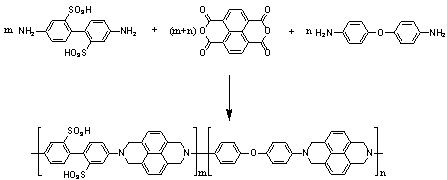Preparation method of sulfonated polyimide/titanium dioxide composite proton conductive membrane
A technology of sulfonated polyimide and proton conductive membrane is applied in the field of preparation of battery separator, which can solve the problems of affecting the long-term service life of the battery, poor anti-oxidation ability of the separator, and decreased battery capacity, etc., and achieves good application prospects and superior chemical properties. , Excellent effect of open circuit voltage
- Summary
- Abstract
- Description
- Claims
- Application Information
AI Technical Summary
Problems solved by technology
Method used
Image
Examples
Embodiment 1
[0026] A preparation method of sulfonated polyimide / titanium dioxide composite proton conductive membrane:
[0027] Under N2 protection, 1.0 mmol BDSA, 10 mL m-cresol, 2.0 mmol triethylamine were added to a 100 mL three-necked flask, and stirred continuously at room temperature until BDSA was completely dissolved, then 2.0 mmol NTDA, 0.49 g benzoic acid and 1.0 mmol ODA were added, After continuing to stir for a few minutes, the temperature of the system was raised to 80 °C for 4 hours, and then to 180 °C for 20 hours, and the heating was stopped to obtain a viscous polymer solution. When the temperature drops below 80 °C, add 5 mL of m-cresol to dilute the reaction solution, continue to stir for a few minutes, then pour acetone into it to obtain a flocculent polymer precipitate, filter it, and wash the precipitate repeatedly with acetone several times to remove the residual solvent and unreacted substances, and then dried at 80°C for 20 hours;
[0028]Dissolve the obtained t...
Embodiment 2
[0032] A preparation method of sulfonated polyimide / titanium dioxide composite proton conductive membrane:
[0033] Under the protection of N2, add 1.2 mmol BDSA, 10 mL m-cresol, 2.4 mmol triethylamine to a 100 mL three-necked flask, stir continuously at room temperature until BDSA is completely dissolved, add 2.0 mmol NTDA, 0.49 g benzoic acid and 0.8 mmol ODA, After continuing to stir for a few minutes, the temperature of the system was raised to 80 °C for 4 hours, and then to 180 °C for 20 hours, and the heating was stopped to obtain a viscous polymer solution. When the temperature drops below 80 °C, add 5 mL of m-cresol to dilute the reaction solution, continue to stir for a few minutes, then pour acetone into it to obtain a flocculent polymer precipitate, filter it, and wash the precipitate repeatedly with acetone several times to remove the residual solvent and unreacted substances, and then dried at 80°C for 20 hours;
[0034] Dissolve the obtained triethylamine salt-t...
Embodiment 3
[0038] A preparation method of sulfonated polyimide / titanium dioxide composite proton conductive membrane:
[0039] Under N2 protection, add 1.0 mmol BDSA, 10 mL m-cresol, 2.0 mmol triethylamine to a 100 mL three-necked flask, stir continuously at room temperature until BDSA is completely dissolved, add 2.0 mmol NTDA, 0.49 g benzoic acid and 1.0 mmol ODA, continue After stirring for a few minutes, the temperature of the system was raised to 80 °C for 4 hours, and then to 180 °C for 20 hours, and the heating was stopped to obtain a viscous polymer solution. When the temperature drops below 80 °C, add 5 mL of m-cresol to dilute the reaction solution, continue to stir for a few minutes, then pour acetone into it to obtain a flocculent polymer precipitate, filter it, and wash the precipitate repeatedly with acetone several times to remove the residual solvent and unreacted substances, and then dried at 80°C for 25 hours;
[0040] The sulfonated polyimide of the obtained triethyla...
PUM
| Property | Measurement | Unit |
|---|---|---|
| Thickness | aaaaa | aaaaa |
| Particle size | aaaaa | aaaaa |
| Proton conductivity | aaaaa | aaaaa |
Abstract
Description
Claims
Application Information
 Login to View More
Login to View More - Generate Ideas
- Intellectual Property
- Life Sciences
- Materials
- Tech Scout
- Unparalleled Data Quality
- Higher Quality Content
- 60% Fewer Hallucinations
Browse by: Latest US Patents, China's latest patents, Technical Efficacy Thesaurus, Application Domain, Technology Topic, Popular Technical Reports.
© 2025 PatSnap. All rights reserved.Legal|Privacy policy|Modern Slavery Act Transparency Statement|Sitemap|About US| Contact US: help@patsnap.com


